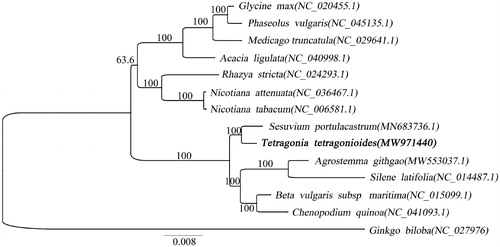Abstract
The complete mitochondrial genome sequence of Tetragonia tetragonioides (Pall.) Kuntze was assembled and characterized in the present study. The mitochondrial genome was 347,227 bp in length and had a GC content of 43.84%, including 24 transfer RNA (tRNA) genes and three ribosomal RNA (rRNA) genes. Phylogenetic analysis showed that T. tetragonioides was close to and Sesuvium portulacastrum.
The Tetragonia tetragonioides (Pall.) Kuntze is an annual plant belonging to the family Aizoaceae. It is widely distributed in subtropical and temperate coastal salt-rich areas, which is rich in iron, calcium and a variety of vitamins. It can also be used as medicine to clear heat and detoxify, dispel wind and detumescence, implying a high medicinal value. As a kind of halophyte with high salinity tolerance, the T. tetragonioides can tolerate seawater and survive normally on salinized land. It can be used for the improvement and utilization of seawater irrigation farmland in salt wasteland of coastal land (Wilson et al. Citation2000).
Fresh leave samples were collected from T. tetragonioides in Binzhou, China (N 38.20, E 117.96). The samples were deposited at the Shandong Marine Resources and Environment Research Institute (number: SMRERI_20200712, collected by Shunxin Hu, e-mail: [email protected]). Genomic DNA was extracted from the samples with Qiagen DNeasy Plant Mini Kit (Qiagen, Carlsbad, CA, USA). The mitochondrial genome of T. tetragonioides was sequenced using a combination of the Illumina NovaSeq 6000 platform and PacBio Sequel II. We used the GetOrganelle v1.7.1 to assemble the Illumina sequencing data. The assembled sequences were checked whether there are overlapping sequences, which were then manually corrected.
The average read coverage of the genome was 3209. Finally, the complete mitochondrial genome of T. tetragonioides was a circular form of 347,227 bp, which had a GC content of 43.84%. The total length of the protein-coding genes was 29,229 bp, accounting for 8.42% of the genome length. The total length of non-coding-proteins genes was 4658 bp, including 24 transfer RNA (tRNA) genes and three ribosomal RNA (rRNA) genes (rrn18, rrn5, rrn26). In addition, we totally found 22 introns in nine genes (nad1, nad2, nad4, nad5, nad7, ccmFc, rps3, clpP1, cox2).
In order to further investigate the phylogenetic position of T. tetragonioides, we construct a phylogenetic analysis with the mitochondrial genomes of other 13 plants. The mitochondrial genomes sequence of Ginkgo biloba were used as an outgroup (). The 14 mitochondrial genomes were aligned by MAFFT v7.307 (Katoh and Standley Citation2013). And maximum likelihood (ML) tree was performed by Mega 7.0 (Sudhir et al. Citation2016). The GTR + G model was selected for ML analyses with 1000 bootstrap replicates. And the ML tree was visualized by using iTOL v3.4.3 (Letunic and Bork Citation2016). The phylogenetic results showed that the T. tetragonioides was close to Sesuvium portulacastrum (), since they were both in the Aizoaceae. And the mitochondrial genome information of T. tetragonioides will provide data for further analysis of evolutionary history.
Disclosure statement
No potential conflict of interest was reported by the author(s).
Data availability statement
The genome sequence data that support the findings of this study are openly available in GenBank of NCBI at (https://www.ncbi.nlm.nih.gov/) under the accession no. MW971440. The associated BioProject, SRA, and Bio-Sample numbers are PRJNA740354, SRP325516, and SAMN19842629 respectively.
Additional information
Funding
References
- Katoh K, Standley DM. 2013. MAFFT multiple sequence alignment software version 7: improvements in performance and usability. Mol Biol Evol. 30(4):772–780.
- Letunic I, Bork P. 2016. Interactive tree of life (iTOL) v3: an online tool for the display and annotation of phylogenetic and other trees. Nucleic Acids Res. 44(W1):W242–W245.
- Sudhir K, Glen S, Koichiro T. 2016. Mega7: molecular evolutionary genetics analysis version 7.0 for bigger datasets. Mol Biol Evol. 33(7):1870–1874.
- Wilson C, Lesch SM, Grieve CM. 2000. Growth stage modulates salinity tolerance of New Zealand spinach (Tetragonia tetragonioides, Pall.) and red orach (Atriplex hortensis L.). Ann Bot-London. 85(4):501–509.

